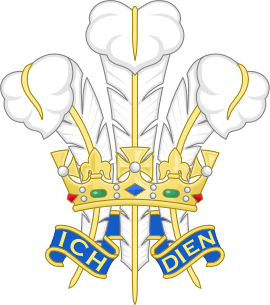Moët & Chandon
Moët & Chandon (French pronunciation: [moɛt‿e ʃɑ̃dɔ̃]),[1] also known simply as Moët, is a French fine winery and co-owner of the luxury goods company LVMH Moët Hennessy Louis Vuitton SE. Moët et Chandon is one of the world's largest champagne producers and a prominent champagne house. Moët et Chandon was established in 1743 by Claude Moët, and today owns 1,190 hectares (2,900 acres) of vineyards, and annually produces approximately 28,000,000 bottles of champagne.[2]
| Part-holder of LVMH | |
| Industry | Winery |
| Genre | French winery |
| Founded | 1743 |
| Founder | Claude Moët |
| Headquarters | 20, avenue de Champagne BP 140, 51333 Épernay France |
Area served | Worldwide |
| Products | French wine |
| Revenue | €1.2 billion (2011) |
Number of employees | 1,715 (2011) |
| Website | www |
| Moët et Chandon | |
|---|---|
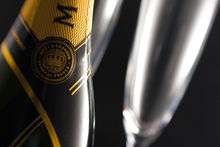 | |
| Wine region | Épernay |
| Appellation | Champagne |
| Cases/yr | 2,000,000 |
| Known for | Dom Pérignon |
| Varietals | Pinot noir, Chardonnay, Pinot Meunier |
| Website | www |
.jpg)
History
Moët et Chandon began as Moët et Cie[1] (meaning "Moët & Co."), established by Épernay wine trader Claude Moët in 1743,[3] and began shipping his wine from Champagne to Paris. The reign of King Louis XV coincided with increased demand for sparkling wine. Soon after its foundation, and after son Claude-Louis joined Moët et Cie, the winery's clientele included nobles and aristocrats.
In 1833, the company was renamed Moët et Chandon after Pierre-Gabriel Chandon de Briailles, Remy Moët's son-in-law, joined the company as a partner of Jean-Remy Moët, Claude Moët's grandson.[4]
Following the introduction of the concept of a vintage champagne in 1840, Moët marketed its first vintage in 1842. Their best-selling brand, Brut Imperial, was introduced in the 1860s. Their best known label, Dom Perignon, is named for the Benedictine monk remembered in legend as the "Father of Champagne".
Moët & Chandon merged with Hennessy Cognac in 1971 and with Louis Vuitton in 1987 to become LVMH (Louis-Vuitton-Moët-Hennessy), the largest luxury group in the world, netting over 16 billion euros in fiscal 2004. Moët & Chandon holds a royal warrant as supplier of champagne to Queen Elizabeth II.[5][3][6]
In 2006, Moët et Chandon Brut Impérial issued an extremely limited bottling of its champagne named "Be Fabulous", a special release of its original bottle with decorative Swarovski crystals, marking the elegance of Moët et Chandon.
Dom Perignon
Dom Pérignon (/ˌdɒmpɛrɪˈnjɒn/; French pronunciation: [dɔ̃peʁiɲɔ̃]) is a brand of champagne produced by Moët & Chandon. It is named after Dom Pierre Pérignon, a Benedictine monk who was an important quality pioneer for Champagne wine but who, contrary to popular myths, did not discover the champagne method for making sparkling wines.[7] Dom Pérignon was the first prestige cuvée, an idea proposed by Englishman Laurence Venn.[8] The first vintage of Dom Pérignon was 1921 and was only released for sale in 1936. It is a vintage champagne, meaning that it is only made in the best years, and all grapes used to make the wine are harvested in the same year. Many champagnes, by contrast, are non-vintage, meaning that the champagne is made from grapes harvested in various years.
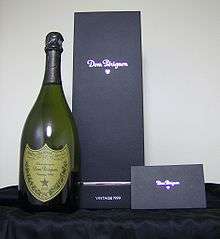 A bottle of vintage 1999 Dom Pérignon with accompanying materials
A bottle of vintage 1999 Dom Pérignon with accompanying materials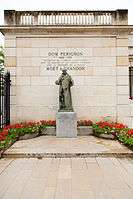 Statue of Dom Pierre Pérignon, a Benedictine monk
Statue of Dom Pierre Pérignon, a Benedictine monk
Current production
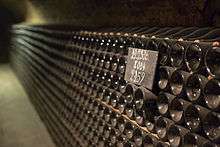
Around 5 million bottles are produced in each vintage.[8] The wine is 60% Chardonnay and 40% Pinot noir, with 6 g/l dosage.[8] According to Tom Stevenson, "All vintages need at least 12 years ageing to nurture Dom Pérignon's signature silky mousse".[8] As of 2008, the current release of Dom Pérignon is from the 2000 vintage[8] and the current release of Dom Pérignon Rosé is from the 1998 vintage. As of 2017 the senior winemaker was Richard Geoffroy, who has been chef de cave for Dom Pérignon since 1990.[9]
Domaine Chandon
In 1973, the then Moët-Hennessy company founded Domaine Chandon, an outpost winery in the Napa Valley. It was the first French-owned sparkling wine venture in the United States. The fine dining restaurant étoile was situated at the winery, closing in December 2014.[10]
Chandon had already founded an outpost in Argentina in 1959, and was doing the same in the southern city of Garibaldi in Brasil in 1973. Domaine Chandon was later established in 1986 in Australia in Coldstream, Victoria, in the Ningxia region in China in 2013 and India's Nashik region in 2014.
Sponsorships
Moët was the official Formula One champagne provider between 1966 and 1999 and again from 2016.[11]
On 30 November 2012, Swiss tennis player Roger Federer became Moët et Chandon's brand ambassador. On 30 September 2015, Chandon announced it would be a sponsor of the McLaren F1 team starting 2016.[12]
Pronunciation
Moët is pronounced with a "t" at the end (IPA: [moɛt]) ('mo-et') as the French-born founder's surname is of Dutch origin.[13][14][15]
Songs
In the band Queen's 'Killer Queen', the lead singer Freddie Mercury sings "She keeps her Moet et Chandon in her pretty cabinet".
Musician Prince mentions "a little Spanish man offering wine and Moët" in his song "Mr. Goodnight" from his "Planet Earth" album.
In his song "Big Poppa", the rapper Notorious B.I.G. sings "at the back of the club sipping Moët is where you'll find me".
In his song, "Comin Thru", Chali 2na sings "I don't drink, my glass never will hold Moët."
In his song "Check Out My Melody", Rakim says: "Emcees that wanna be best, they're gonna be dissed if they don't get from in front of All they can go get is me a glass of Moët A hard time, sip your juice and watch a smooth poet..."
In his song, "The Way Life Goes", the rapper Lil Uzi Vert sings "She's sipping Moët, and yeah, I swear it gets her wetter..."
Craig David mentions Moët as part of his week-long date plans in the song "7 Days."
In his song "Bloodless", Andrew Bird sings "And the poets, they explode like bombs, While the gentry is drinking Moët Chandon"
References
- "History of Moët at Chandon". Retrieved 17 May 2008.
- T. Stelzer (2013). The Champagne Guide 2014-2015. Hardie Grant Books. p. 261. ISBN 9781742705415.
- "Moët & Chandon". Retrieved 17 May 2008.
- Paul, Harry W. (2002). Science, Vine and Wine in Modern France. Cambridge University Press. p. 218. ISBN 9780521525213. Retrieved 16 April 2018.
- The Royal Warrant Holders Association
- "Champagne Moet & Chandon | Royal Warrant Holders Association". www.royalwarrant.org. Retrieved 16 March 2018.
- D. & P. Kladstrup Champagne pg 38 Harper Collins Publisher ISBN 0-06-073792-1
- Stevenson, Tom (2007) The Best A Man Can Get p65 Dec 2007 Decanter
- Walton, Annunciata. Dom Pérignon’s chef de cave on life, grapes and his favourite vintage. Country Life, 28 March 2017
- "Moët & Chandon replace Mumm Champagne as sponsor of Formula 1". Glass of Bubbly. Retrieved 24 May 2016.
- "Profile: Moët & Chandon". Retrieved 20 October 2015.
- "It's official: Nike rhymes with spiky - and you're saying all these wrong too=The Guardian". Retrieved 17 April 2017.
- "Guide to pronunciation: from Moët to diplodocus". The Telegraph. Retrieved 17 April 2017.
- Enting, Carolyn (2002). "Moët for Linguists". Lucire Living Magazine.
External links
| Wikimedia Commons has media related to Moët & Chandon. |
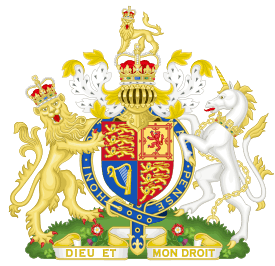
.svg.png)

